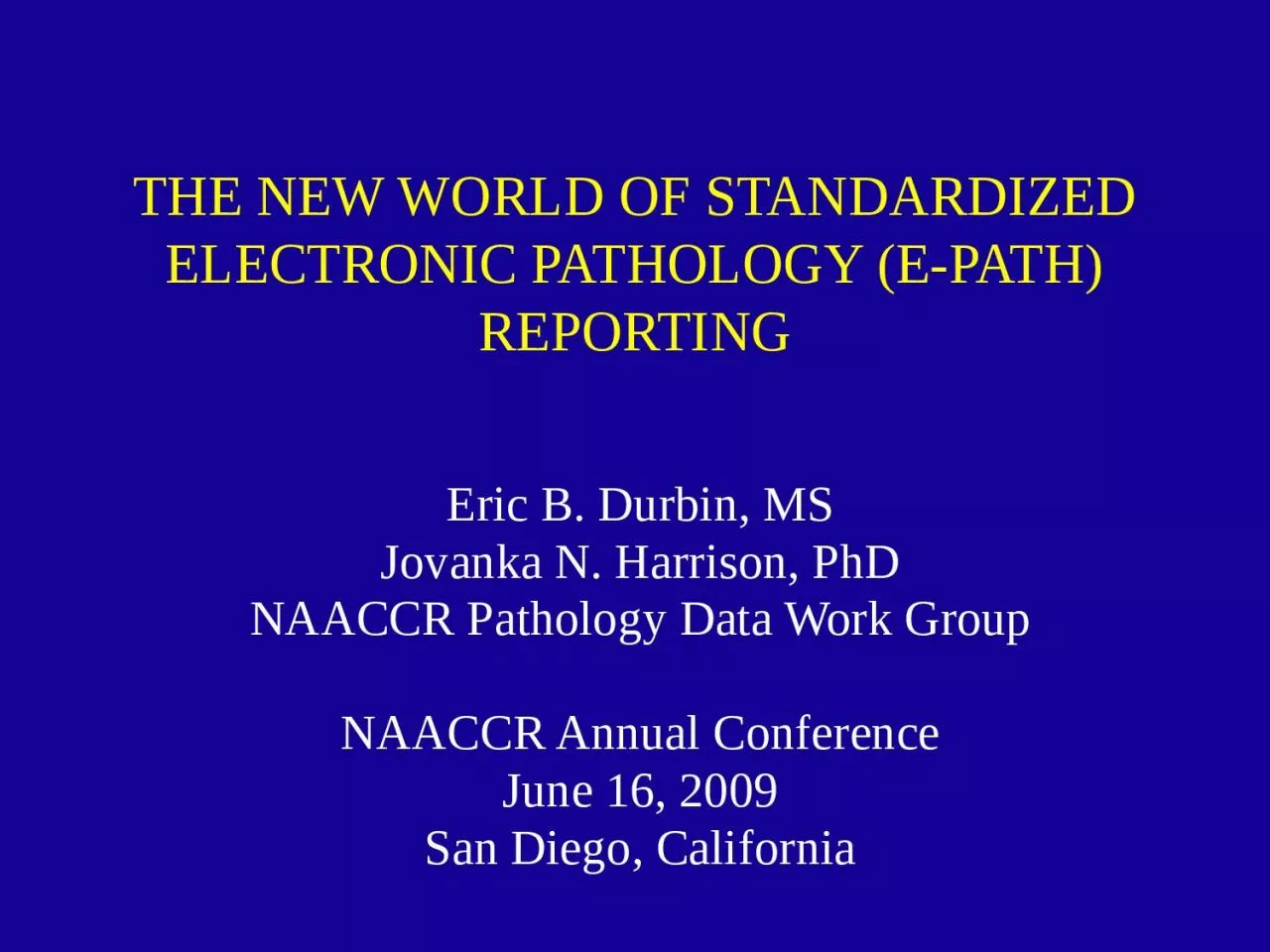

Eric B Durbin MS Jovanka N Harrison PhD NAACCR Pathology Data Work Group NAACCR Annual Conference June 16 2009 San Diego California Overview Importance of data standards History ID: 1028580
Download Presentation The PPT/PDF document "THE NEW WORLD OF STANDARDIZED ELECTRONIC..." is the property of its rightful owner. Permission is granted to download and print the materials on this web site for personal, non-commercial use only, and to display it on your personal computer provided you do not modify the materials and that you retain all copyright notices contained in the materials. By downloading content from our website, you accept the terms of this agreement.
1. THE NEW WORLD OF STANDARDIZED ELECTRONIC PATHOLOGY (E-PATH) REPORTINGEric B. Durbin, MSJovanka N. Harrison, PhDNAACCR Pathology Data Work GroupNAACCR Annual ConferenceJune 16, 2009San Diego, California
2. OverviewImportance of data standardsHistory of NAACCR E-Path standardsNAACCR HL7 E-Path messagesSynoptic reportingConformance testingDiffusion of NAACCR E-Path Standards
3. Who Needs Standards for Electronic Pathology Reports?95% of all cancer cases are microscopically confirmed in a pathology reportData standards facilitate transmission of critical pathology data from pathology labs to cancer registriesImproves registry accuracy and efficiencyOne interface fits allReduces costsOne interface fits all
4. History of E-Path Data StandardsNAACCR Pathology Data Work GroupData Standards for Cancer RegistriesPathology Laboratory Electronic ReportingSeptember 2000 (Volume II, Chapter 6)November 2005 (Volume V, Version 2.0)May 2008 (Volume V, Version 2.1)February 2009 (Volume V, Version 2.2)June 2009 (Volume V, Version 3.0)URLhttp://www.naaccr.org/index.asp?Col_SectionKey=7&Col_ContentID=122
5.
6. Acknowledgements
7. NAACCR Volume VChapter 2: Implementation Guide for Transmission of Laboratory-Based Reports to Cancer Registries Using Version 2.X of the HL7 Standard ProtocolVolume V Version 2.1 (May 2008)HL7 Version 2.3.1Volume V Version 3.0 (June 2009)HL7 Version 2.5.1
8. Why Health Level Seven (HL7)?Flexible and robust protocolWidely utilized for electronic data transmissionsElectronic Medical Record (EMR) systemsPathology Laboratory Information Systems (LIS)Widely utilized inUSCanadaEuropeFederal mandates likely on the horizon
9. NAACCR Pipe-Delimited FormatNot widely utilizedLimited cancer registriesLimited pathology LIS systemsLess sophisticated (less technically challenging)Retained for legacy e-path reporting systemsMay be used alone or in conjunction with HL7
10. NAACCR Volume V: Chapter 2HL7 Implementation GuideDefines HL7 messages for transmitting pathology reports to cancer registriesSpecifies how to encode path report data elementsDefines requirement status for each HL7 field(R) Required(RE) Required but may be empty(C) Conditional(CE) Conditional but may be empty(X) No supported
11. HL7 Basics: Delimited, Positionally Defined Data FieldsHL7 messages are ASCII textAll data fields are delimited by a specified separatorsDelimiters defined at beginning of messageFields usually delimited by ‘|’ (pipe) characterSub-fields usually delimited by ‘^’ (hat) characterStandard for each field position specifically defined
12. HL7 Basics: SegmentsVarious HL7 segments carry categories of informationEach segment type identified by three character id at the beginning of the segmentMSH, PID, ORC, OBR, OBX, SPMSome segments types are optionalSome can be repeatedRepeats are sequentially numberedOBX|1|TX|22637-3^FINAL DIAGNOSIS^LN^^DIAGNOSIS^L|1|LEFT INGUINAL LYMPH NODE - GRANULOMATOUS LYMPHADENITIS||||||F<CR>OBX|2|TX|22637-3^FINAL DIAGNOSIS^LN^^DIAGNOSIS^L|1|/ljm <CR>OBX|3|TX|^^^^Clinical History^L|2|? lymphoma Quick Section||||||F<CR>
13. NAACCR HL7 E-Path Message Structure
14. HL7 E-Path OBX SegmentObservation/Result (OBX) SegmentSpecific observation identifier or “question” (OBX-3)Identified by LOINC or SNOMED CodesSpecific observation or “answer” (OBX-5)Primarily narrative text
15.
16.
17. Next Steps: Encoded SynopticE-Path ReportsCollege of American Pathologists (CAP) define standard Cancer Protocols and Checklists for all pathology reportshttp://www.cap.org/Protocols and checklists specified by site and procedureBreast, Colon and Rectum, Lung, Prostate, etc.Biopsy, resection, etc.Pathologists follow CAP Protocols when evaluating specimensComputerized, “synoptic” reports contain discrete encoded data elementsNAACCR HL7 standard can accommodate encoded synoptic pathology reports
18. NAACCR HL7 Conformance Testing and ValidationHL7 Messaging Workbench (MWB) Standalone software application for validating the conformance of HL7 messagesCan be used by vendors and registries to validate E-Path HL7 messagesProfile for NAACCR HL7 standard available on NAACCR web site
19. Real World Implementations of NAACCR HL7 StandardCAP survey of 25 LIS vendorsPublished in February 2009Use of NAACCR standards to report to tumor registries or public health agencieshttp://www.cap.org/apps/docs/cap_today/0209/0209_CAPTODAY_AnatPathol_ProdGuide.pdfElectronic Interface Description (N=25)Number (%)NAACCR Volume V Version 2.1 Available11/17 (65%)NAACCR Volume V Version 2.1 Installed 4/17 (24%)Older NAACCR Standard Installed8/17 (47%)Non-Standard Interface Installed10/17 (59%)No Answer8 /25 (32%)
20. Fruits of Our LaborsNew PHINMS E-Path transmissions to Kentucky Cancer Registry:“I consulted Volume V and found everything I needed.”Dr. Sally Bushhouse Minnesota Cancer Surveillance SystemJune 16, 2009
21. Contact InformationEric B. Durbin, MSDirector of Cancer InformaticsMarkey Cancer Control Program/Kentucky Cancer RegistryMarkey Cancer CenterUniversity of Kentucky2365 Harrodsburg Rd, Ste A230Lexington, KY 40504-3381ericd@kcr.uky.edu(859)219-0773 x223